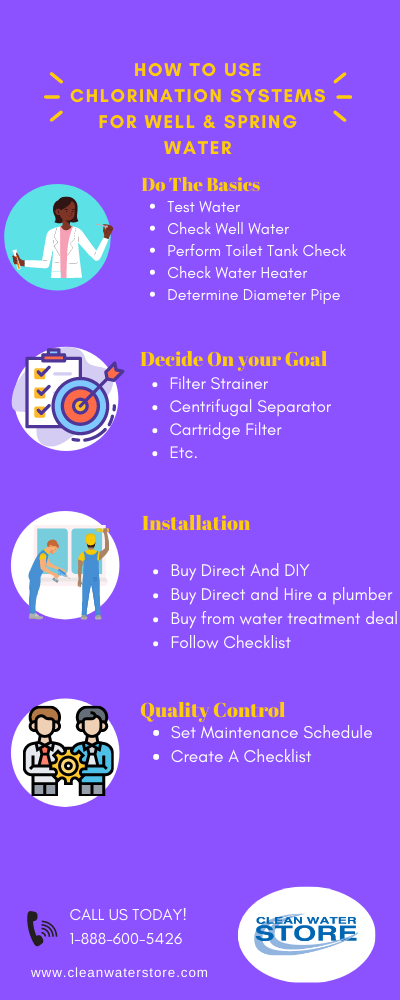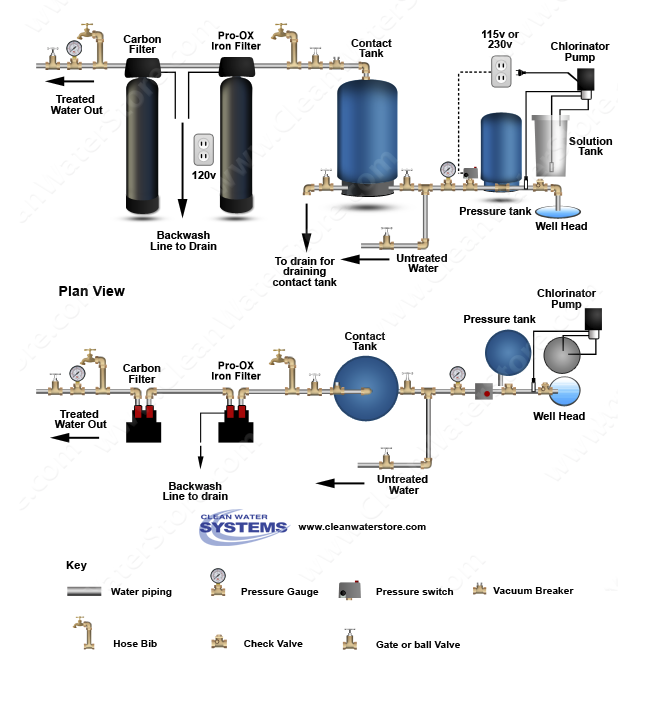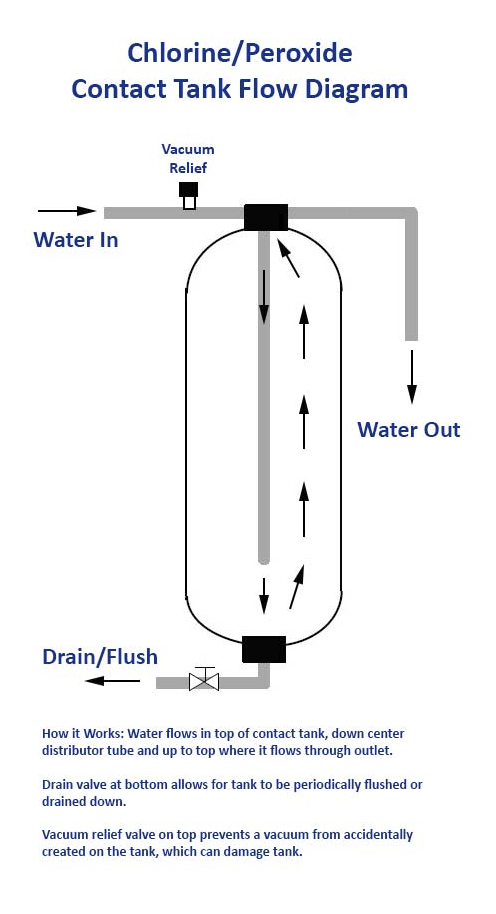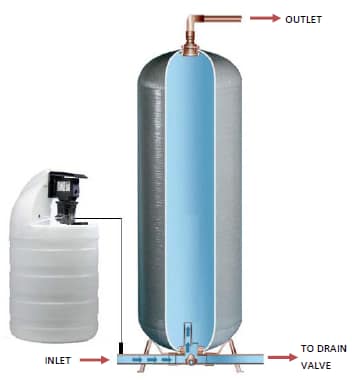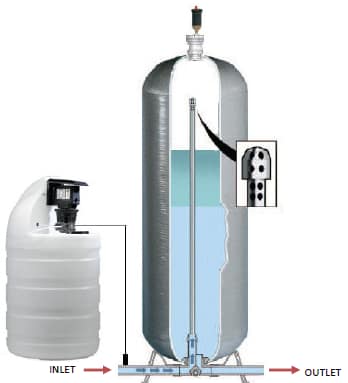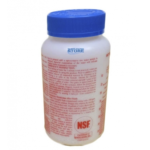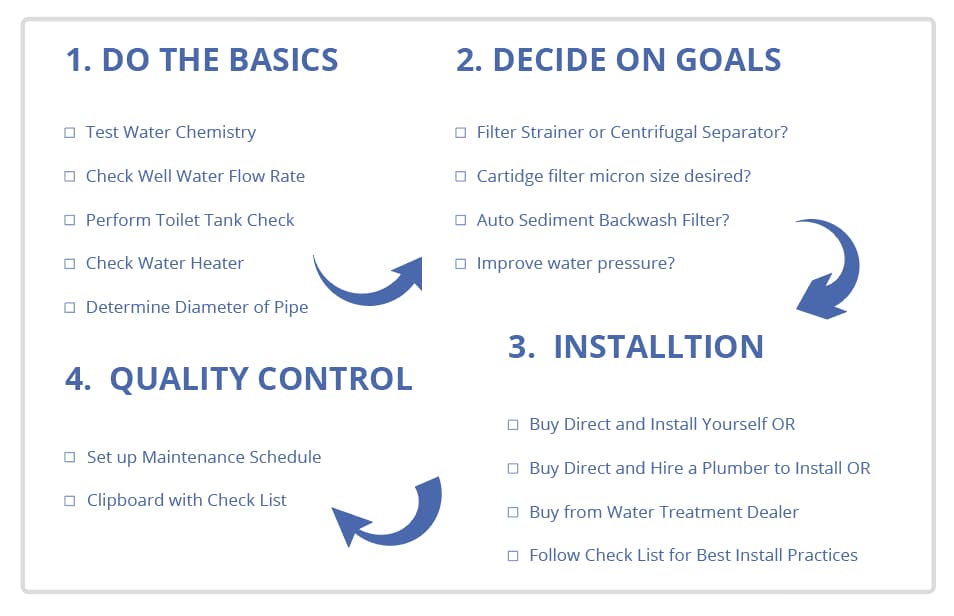Although several methods eliminate microorganisms and odors in water, chlorination is the most commonly used. A chlorination system is effective against many pathogenic and non-pathogenic bacteria, but it does not kill all viruses, cysts, or worms at normal dosage rates.
Water used for drinking and cooking should be free of odor, slime-producing bacteria, and pathogenic (disease-causing) microorganisms that cause such illnesses as typhoid fever, dysentery, cholera, and gastroenteritis.
Often combined with a water filtration system, Chlorination Systems are an excellent and cost-effective way to disinfect drinking water supplies, eliminate odors, and oxidize iron and other metals.
The two most common methods of chlorination for residential well water systems are:
- Chlorine bleach (sodium hypochlorite)
- Solid bleach pellets and powders (calcium hypochlorite)
Questions to Ask When Choosing a Well Water Chlorinator:
- Have I had my water tested?
- What is the “chlorine demand” (based on my water test) of my water?
- What is the flow rate of my well pump in gallons per minute?
- How much contact time do I have after the chlorine is injected, and will a contact tank be necessary?
- What is the line pressure in PSI at the point where I plan to inject the chlorine?
Test Your Water
A general mineral analysis will provide a list of the common minerals. Important items to test for include:
- Coliform bacteria
- Alkalinity
- ph
- Hardness (calcium carbonate)
- Iron
- Manganese
- Total dissolved solids
Stains and Odors
If water is discolored or has a strong odor, you may also want to test for:
- Iron Bacteria
- Tannin
- Hydrogen sulfide
Chlorination Systems: Professional Analysis or Home Test Kit?

If there is an odor problem with the water supply, the first step is to determine the source. If the source is from the well directly, a general mineral water analysis is critical to select the correct water treatment system.
To find a local lab, consult your county health department for recommendations.
The water sample should be drawn as close to the source as possible before any filtration Chlorination Systems.

Allow water to run for 5 to 10 minutes, ensuring that you are getting a sample coming directly out of the well and has not been sitting in pipes or pressure tanks.
You can also use a laboratory analysis water test kit. This kit contains a freeze pack with special bottles for sending by overnight UPS or FEDX to the lab. Extensive analysis for bacteria, general minerals, metals, and chemicals are available for a relatively low cost.
Click here to learn more about Chlorination Systems for Well & Spring Water.
Estimate Chlorine Demand for Chlorine Water Treatment
When chlorine is added to water, it reacts with bacteria and other impurities, such as hydrogen sulfide, soluble metals, organic matter particles, and other microorganisms. The chlorine demand must first be satisfied before a residual chlorine concentration can establish.
Once there is a residual chlorine concentration, this residual concentration must maintain during the required contact time to kill pathogenic microorganisms. To adequately disinfect the water, it is required to supply the water with a higher chlorine concentration than the concentration required to kill bacteria.
Chlorine demand is how much available, or “free” chlorine in mg/L or PPM is needed to kill the bacteria, remove odor, and/or oxidize iron to achieve your goals.
Amount of chlorine required to kill bacteria and oxidize iron, manganese, and hydrogen sulfide:
* Based on CT Values recommended by USEPA. CT value is the Concentration of chlorine multiplied by Time in retention. C x T = CT value. The less Concentration of chlorine you have, the longer the contact time required.
Example: Common well water analysis and chlorine demand calculation:
Note, calculations for Chlorine Demand do not have to be exact. Once the system is up and running, a simple free-chlorine test will let you know your chlorine demand after the contact tank. The chlorinator can then be easily adjusted to put out more or less chlorine as needed.
pH:
Chlorine is most effective if the water has a pH in the range of 6.0 to 7.5. At pH 8.0, much more chlorine is required to have the same effect as if the water had a pH of 7.0. At pH over 8.5, chlorine becomes ineffective as a disinfectant.
Temperature:
The warmer the water, the more effective free-chlorine is in disinfecting water and oxidizing iron. Colder water less than 10C (50F) requires longer contact times and higher chlorine concentrations than the examples shown.
CT Values:
CT values have been set by USEPA and WHO guidelines to show how much Concentration of chlorine and the Time required to inactivate bacteria and viruses. C x T = CT.
Chlorination Systems: Determine Your Well Pump Flow Rate
When choosing a well water system, it is important to know your well pump flow rate. A well pump can pump water up to a certain maximum flow rate, in gallons per minute.
For example, say you could fill a 5-gallon bucket in 1 minute. This is a flow rate of 5 gallons per minute or 5 GPM. If the water fills up a 5-gallon bucket in 30 seconds, the flow rate would 10 GPM.
Knowing how many gallons per minute your water system can pump is critical to picking the right type of well water chlorinator, and it is easy to determine!
All you need is a 1 or 5-gallon bucket and a watch or clock. It takes just a few minutes:
1. Open any hose bib or faucet until the pump turns on.
2. Close the hose bib or faucet and let the pump fill up the pressure tank until it turns off.
3. Using a 1 or 5 gal. Bucket, open faucet, collect and measure all water discharged until the pump turns on.
4. When the pump turns on, immediately close the faucet and start timing the pump cycle.
5. When the pump turns off, record pump cycle time to refill the pressure tank in seconds.
6. Divide the number of gallons collected in Step 3 by the number of seconds in Step 5.
7. Multiply the answer from Step 6 by 60.
8. The answer in Step 7 is the average pumping capacity of the pump in gallons per minute (GPM).
Systems with Variable Speed “Continuous Pressure Pumps”
Note: Some well pumps are what they call “continuous pressure pumps.” They don't turn on at one pressure and off at another.
Perform a “Toilet Tank Inspection

Unless your toilet tank is new or has recently been cleaned, your toilet flush tank can be a wealth of useful water quality information!
Lift the cover and look in. If you see slimy rusty deposits on the sides of the tank and frothy bubbles in the tank water, it is a good indication of iron bacteria.
Determine Contact Tank Size Required
With a chlorine injection system, whether you are injecting chlorine with a liquid bleach chlorinator using a metering pump or using a solid chlorine pellet feeder, you need a certain amount of contact time after the chlorine has been injected for the chlorine to work properly.
Well Water Flow Rate in GPM X Contact Time in Minutes x Baffle Factor = Contact Tank Size in Gallon.
For example, your well pump is pumping at 10 gallons per minute (“GPM”).
You have coliform bacteria and want 10 minutes of contact time. You plan to use a contact tank that has a baffle factor of 0.40. The best contact tanks use an internal baffle or distributor for better mixing.
For example, a 120-gallon contact tank with a .4 baffle factor gives you 48 gallons in contact or retention time.
10 GPM x 10 minutes = 100 Gallons
Therefore, you would have two 120 gallon contact tanks to give you approximately 10 minutes of contact or retention time.
Metering pumps are used to inject a small amount of chlorine (sodium hypochlorite solution, or calcium hypochlorite solution) into the water, usually in conjunction with a contact tank. The pumps draw chlorine bleach from a solution tank and pump it into a pipe under pressure.
Three ways to turn the well water chlorinator pump on and off:
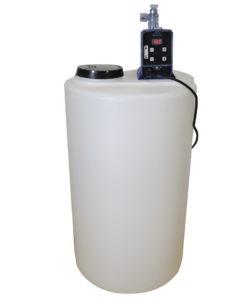
Chlorinator metering pumps need to be installed, so they turn on and off automatically. There are three methods commonly used:
1. The well pump pressure switch;
2. A flow switch; or
3. A proportional-feed flow meter.
1. By Well Pressure Switch: In this type of installation, the metering pump is plugged into a dedicated electrical outlet wired into the pressure switch. When the pressure switch points close, the Stenner chlorine solution pump is turned on. Lowest cost.
2. Flow Switch: An alternative to installing a dedicated outlet and wiring to the pressure switch is to use a pre-wired flow switch. The flow switch cord is plugged into any 120V wall outlet. The Stenner pump is plugged into the outlet that is built-in to the flow switch. Whenever there is flow, the Stenner pump is energized and starts to pump. Easy to wire, plugin, turn on.
3. Proportional-Feed: In some applications, the chlorine injection point must be after the pressure tank, such as when the pressure tank and well are away from the house, and it's impractical to install the chlorine system at the well. In this case, a Proportional-Feed system can be used.
Based on how fast the water is flowing, more or less chlorine is pumped into the water, maintaining a precise residual. Also, a very easy chlorination system to install and allows installation anywhere after the well pressure tank. For community chlorination systems where it is not practical to install the injection point, it can go before the well pressure tank.
Two Methods to Set up Contact Tanks:
1. Water enters at bottom exits at the top
This method is the most common and is useful for settling sand and sediment out in the contact tank. At the bottom, a simple ball valve allows one to drain and flush the accumulated iron and sediment tank.
2. Water enters in at the bottom, exits at the bottom.
This method is useful when there is air or gasses in the water. Water travels up a center tube and then back down through the water. Any gasses or air present accumulate at the top and are vented off by the air vent.
• Best for applications where gasses are present in the well water
• Provides contact time
• Vents off-gasses
• Air compressor (optional)
How to Determine Chlorine Solution Strength and Metering Pump Size
Step 1: Determine the flow rate of the water stream you are injecting into, in Gallons Per Minute (GPM) or Liters Per Minute (LPM).
Step 2: Determine the parts per million of chlorine you are trying to achieve (PPM). This is the chlorine residual based on estimated chlorine demand.
Step 3: Use the formula below to compute the gallons per day and select the pump. Pumps are sized in gallons output per 24 hours, gallons per day.
Step 4: Adjust the output of the metering pump to achieve proper dosage.
Formula: Multiply the Flow Rate (in gallons per minute) times the Applied Dosage in Parts Per Million Desired times 1440. Then divide by the Solution Strength being used. Flow Rate GPM X Chlorine PPM x 1440 divided by Solution Strength in PPM.
Example Formula: Assume that you have a well pump with a flow rate of 12 gallons per minute (12 GPM) and that you want to inject 4.0 ppm of chlorine into the water.
You have decided to use a solution strength of 12,000 ppm or 1 gallon of 12% bleach to 9 gallons of purified or at least softened water.
There are 1440 minutes in 24 hour period, and the formula will tell you how many gallons of chlorine you will use for every 24 hours the well pump runs.
The formula is:
12 GPM x 4.0 PPM x 1440 and then divided by 12,000 = 5.8 Gal. Per Day
This means that you need a metering pump that has an output of 5.8 gallons per day.
You can use the Chlorinator Well Water Package J-PRO-22, which has a maximum output of 22 gallons per day, and set the pump at 26% speed.
Your well pump might run for 1 hour a day, so at this rate, you would use 5.8 gallons of your chlorine bleach solution every 24 hours the pump runs.
Or in other words, for every hour your well pump runs, you would use 0.24 gallons of your chlorine solution.
Whatever your initial setting, be sure to test for total and free-chlorine and then adjust the pump and/or the solution strength to achieve your desired free-chlorine residual in your piping.
Solid Pellet Chlorinators
In-Line or Well-Mount Pellet Feeder

Calcium hypochlorite is used in solid pellet chlorinators. Calcium hypo is 65% chlorine and a very strong oxidizer.
The Model 400 In-Line chlorinator will operate on a varying pressure such as a home well system or a constant pressure such as a sprinkler or pool system. The chlorinator is adjustable, but the exact dose cannot be controlled as easily as the liquid chlorinators using a metering pump. Often the minimum adjustment allows a chlorine residual of 3 to 5 ppm to enter the water, so a contact tank and a carbon filter are recommended after the system, especially if used for residential applications.
Typical installation where the in-line solid pellet chlorinator is installed after the pressure tank and before the contact tank.
Liquid chlorine bleach (sodium hypochlorite)
• Easy to use and mix
• Mixes and dilutes rapidly
• Use certified chlorine for drinking water or make your own liquid bleach with NSF-certified dry powdered bleach.
• Lower cost than dry chlorine
• Needs to be kept away from sun and heat
• Decays rapidly; use bleach within 2 – 3 months
Pool bleach or commercial grade chlorine bleach is typically 10% to 12% chlorine or 100,000 PPM to 120,000 PPM. Do not use laundry bleach for drinking or potable water. Better to use NSF certified chlorine or liquid pool chlorine (sodium hypochlorite).
NOTE: If you cannot find ‘certified bleach' specifically for drinking water, you can use powdered NSF certified bleach and make your own liquid bleach.
This is widely available.
In-Line Feeders are installed on the pipe after the pressure tank:
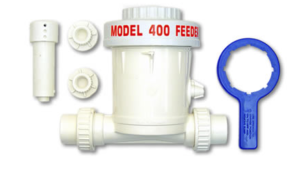
• No electrical power required
• Easy to fill and re-fill
• Easy to install and adjust
• Heavy iron may foul the pellet feeder
• Very hard water may cause the feeder to clog with calcium build-up
Well-Head Pellet Feeders
• Mounts on top of well
• Easy to fill and re-fill
• Easy to install and adjust
• Uses well as a contact tank
• May help well resist fouling from iron bacteria slime.
• Excess pellet feeding may cause damage to well pumps
CT Values
- The CT Value is the Concentration multiplied by the contact or retention Time.
- Higher concentrations of chlorine are needed if the contact time is less. A longer contact time is desirable.
- A 3 log removal means a 99.9% removal rate. A 4.0 log removal rate is 99.99%.
- The higher the temperature, the less contact time is required.
- The higher the pH over 7.0, the higher the concentration of chlorine is needed.
CT Values for Inactivation of Viruses by Free Chlorine
Example:
The well water temperature is 50F or 10C. We want a 4.0 log reduction of viruses. Our pH is 7.0. Therefore the CT value applicable is 4. We have wanted to inject 1.0 ppm of chlorine and have a contact time of 4 minutes to achieve our CT value.
For home water chlorination systems where there is no operator constantly watching over the system and checking the water quality, we recommend a doubling of these figures, so 1 .0 and 8 minutes of contact time is typically recommended.
Other contaminants in the water, such as iron, manganese, turbidity, tannin, organic matter, ammonia, and sediment, can affect the amount of chlorine required and contact time. If there is a chance of pathogenic organisms present, it is better to err on the safe side and use a higher CT value.
https://www.youtube.com/watch?v=w5ciS0342c8
Questions?
You can email our technical support department with your water treatment questions at [email protected] or call us for help at 1-888-600-5426!
Chlorination System for Well Water CHEAT SHEET

